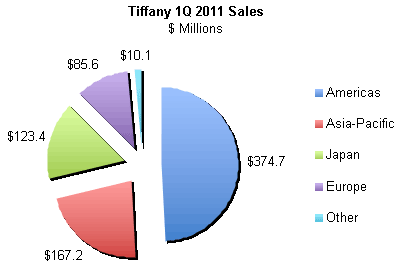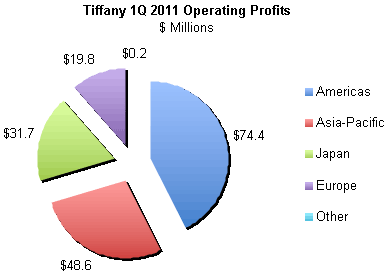IDEX Online Research: Economic Recovery Provides Springboard for Tiffany’s Growth
June 09, 11
(IDEX Online) - Smart jewelers use a recession to re-group, re-think, and re-strategize. Other jewelers use a recession as an excuse for hand-wringing, moaning, and complaining. Guess what kind of jeweler Tiffany is?
While Tiffany suffered just as much as – maybe more than – other jewelers in the recent recession, we never heard one word of complaint. Rather, we heard that management was seeking real estate deals for new stores – 19 new stores this year, for example. The best real estate deals for retailers are made when the market is depressed. Management also accelerated its new product development, so shoppers would have ample reason to come into its stores to see “what’s new.” Finally, the company began developing new marketing plans for the inevitable rebound that we are experiencing now.
Tiffany’s first quarter financial results confirm the wisdom of management’s strategy: sales were stronger than expected, and profits soared. The company operated in a “lean and mean” cost mode; that provided a boost to profits.
Management has also been unafraid to raise prices in the face of higher commodity costs. According to Tiffany’s top people, shoppers know that commodity prices –primarily precious metals and diamonds – are rising, so they have accepted higher prices with little or no resistance.
Here’s what is particularly interesting about this strategy: Tiffany’s annual inventory turn in the first quarter was about 0.74 times (a turn of about every 15 months or so), one of the lowest in the industry. In other words, they were selling a lot of goods that contained commodities purchased at a much lower cost than today’s prices. As a result, the company’s gross margin rose in the quarter.
While the Tiffany name provides tremendous brand recognition and an unusual competitive differential in the jewelry industry, we continue to believe that other jewelers could take lessons from Tiffany. In our opinion, the risk is worth the reward.
The table below provides financial highlights of the company’s first quarter ended April 2011.

First Quarter Highlights
Here are some of the highlights of Tiffany’s first quarter.
· Total global sales rose by 16% and same-store sales were up 15%, on a constant currency basis. In the
· Sales drivers in Tiffany’s stores in the
o An increase in the average price per unit sold.
o Higher unit sales volumes.
o Increased sales both to domestic and international customers.
o Greater demand for engagement jewelry.
o Increased sales of high-end statement jewelry.
· Sales in Tiffany’s non-store direct-marketing division in the
· Sales in almost all international markets also showed the same pattern: a higher average ticket and a greater number of units sold. The table below summarizes sales performance by geographic region for Tiffany’s first fiscal quarter of 2011.
| Geographic Area | Total Sales Gain | Same-Store Sales Gain |
| Worldwide | 16% | 15% |
| | 18% | 17% |
| Asia-Pacific | 31% | 26% |
| | (3%) | (3%) |
| | 19% | 15% |
· While virtually all of the international markets posted substantial gains, there had been some question about prospects in
· On a global basis – all of Tiffany’s 232 stores worldwide – management noted that the following jewelry merchandise categories performed well.
o All major jewelry categories posted double-digit percentage growth in the first fiscal quarter.
o High-end statement jewelry demand was very strong.
o Fine and fashion jewelry sales rose at an above average level. Collections drove much of the demand for fine and fashion jewelry.
o Bridal engagement sales were solid.
o Gold jewelry demand was strong.
o There was also “decent growth” in silver jewelry sales of Tiffany’s own designs.
o Designer jewelry such as Elsa Peretti and Paloma Picasso posted solid gains.
o Watch sales were up more than 30% in the quarter.
o Tiffany’s collection of luxury leather goods also posted a solid gain. As a result, management is expanding distribution of its leather goods into more of its
· The only category which showed notably slower growth was entry level silver jewelry sales. These are mostly the “tourist trinkets” (our term for this jewelry) that Tiffany sells to moderate income customers who shop Tiffany stores for bragging rights.
· Tiffany’s gross margin rose to 58.3% from last year’s 57.8% - an increase of 50 basis points – due to a lower mix of wholesale diamond sales (these sales are at low-to-no margin) as well as sales leverage of relatively fixed operating costs. However, the gain in Tiffany’s gross margin was tempered by higher product costs and a slightly unfavorable sales mix (greater sales of high-ticket goods which carry an inherently lower margin).
· As a percentage of sales, Tiffany’s operating costs fell to 40.4% in the first quarter of 2011 versus last year’s 41.1%, despite unusual costs related to its impending move it the company’s headquarters to lower Manhattan. Excluding those unusual costs, its SG&A ratio would have been better by 1.6 points, rather than the 0.7 points as reported.
Tiffany’s operating margins during the first quarter in each of its geographic divisions were about 20% of sales or better, as the table below illustrates. The only division with minimal profits was its “other” category which consists mostly of wholesale sales of diamonds, an inherently low margin category.
| Tiffany Stores - Geographic Region | Tiffany Operating Margin |
| | 19.9% |
| Asia-Pacific | 29.1% |
| | 25.7% |
| | 23.1% |
| Other (Mostly Wholesale) | 1.8% |
· Sales and operating profit contribution by geographic segment for the first quarter of 2011 are shown on the graphs below.
|
|
· Tiffany posted double-digit pretax and post-tax margins in the first quarter. Its pretax margin in the quarter was 16.5% of sales, and its after-tax margin was 10.7%. Very, very few jewelers post a profit in the first quarter of the year, much less a double-digit profit margin.
· Here is a summary of Tiffany management’s outlook for the balance of 2011.
o Sales in the
o Sales in both the Asia-Pacific region and
o In
o Tiffany plans to open 19 new stores, down from its prior 21 unit forecast. One store in
o Tiffany plans to accelerate the introduction of new, compelling jewelry during the year. The Tiffany Locks collection and the new Twist collection – 18 karat gold and sterling silver – have already been launched. Elsa Peretti’s bottle collection of pendants – a revival for this designer – has been introduced.
o Finally, management is gearing up a strong marketing program for the balance of 2011. Its marketing message is designed to reinforce the instant recognition of the Tiffany name among consumers.

